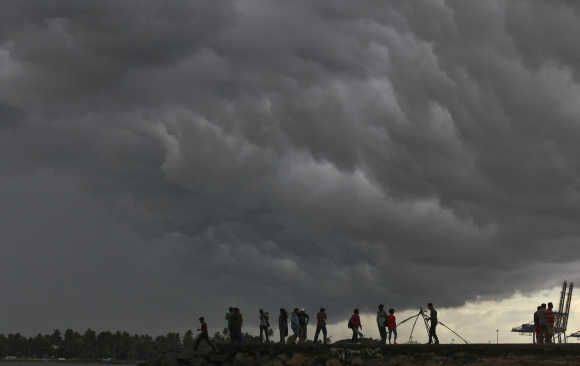 | « Back to article | Print this article |

'All El Ninos are not associated with the deficient monsoon.'
Madhavan Nair Rajeevan, director of the government's Indian Institute of Tropical Meteorology, based in Pune, tells A Ganesh Nadar/Rediff.com that monsoons are difficult to predict.
What phenomena influence the monsoons?
Monsoons are caused by the seasonal reversal of atmospheric pressure and wind patterns. During the northern hemisphere summer, the land gets heated up quickly compared to surrounding oceans and thus reverses the pressure gradient (low over land and high over the south Indian Ocean), this reversal of pressure gradient causes reversal of winds also, we get southwesterly winds during the monsoon season.
The year to year variations of the monsoon are caused by natural variability (internal dynamics) and factors like El Nino/Southern Oscillation (ENSO), Indian Ocean anomalies, snow cover etc.
A Rs 400 crore National Monsoon Mission was announced in 2012.
The monsoon mission was launched with the objective to develop state-of-the-art dynamical models for improved monsoon prediction in all time scales, from short range to seasonal.
Under the monsoon mission, we also collaborate with the national and international academic community to help us in improving monsoon forecasts.
How do you predict the short range, medium range and long range forecasts?
These forecasts are prepared using dynamical models. The dynamical models are mathematical models which represent the dynamics and physics of the atmosphere and oceans.
Prediction is basically an initial value problem, we integrate the models with some initial conditions (initial state of the atmosphere and ocean) to generate future state of the atmosphere and ocean. However, statistical methods are also being used for preparing seasonal forecasts.
What are the weather forecasting models that India currently employs?
The India Meteorological Department uses the Global Forecasting System and Weather Forecasting and Research models for preparing short to medium range forecasts. IITM uses the Climate Forecasting System model for preparing extended range to seasonal forecasts.
What are the new models on weather forecasting that you are working on?
IITM is working on the CFS model to improve its skill for extended range to seasonal forecasts. Already, this model is being used for preparing experimental forecasts.
People say the IMD gets its monsoon prediction right only 50 per cent of the time.
Seasonal forecasting is a difficult task, as only half of the monsoon variability is predictable. However, our analysis shows that our present model has skill much lower than this potential predictability.
The ongoing monsoon mission was initiated with the objective to improve the monsoon forecasts to much higher skill, closer to the limit of predictability.
What are the constraints in the statistical model?
Statistical models are developed based on the statistical relationships between predictors (signals for the ensuing monsoon rainfall) before the monsoon season starts and the monsoon rainfall.
First of all, it is very difficult to identify suitable predictors during the monsoon season. Secondly, the statistical models have known limitations to predict rainfall on a smaller time and spatial scales. The statistical model performs better for all-Indian scale forecast.
How does El Nino affect the Indian monsoons?
During El Ninos, the east and central Pacific Ocean becomes anomalously warm, which forces changes in atmospheric circulation, affecting the monsoon circulation. However, all El Ninos are not associated with the deficient monsoon.
What about the dynamic model that you have adapted from the National Centre for Environmental Prediction in the US?
We have adapted the seasonal forecast model of the NCEP called the CFS version 2.0 for preparing experimental forecasts. This model is one of the best climate models available worldwide. IITM is working on this model to further improve in its skill.
You have sanctioned 30 projects in India and abroad for monsoon predictions. What is the time frame for these projects?
These projects have been given with the objectives to improve the prediction skill of monsoon rainfall. These researchers are working on known problems with the CFS and the UK Met office and helping us to improve the models.
India's most powerful supercomputer is based on your campus. How does it help in weather forecasting?
It helps us in using the models and generating many experimental forecasts. Without this computational capability, it would not have been possible for all these efforts. This computing system is also being used to generate regional climate change scenarios.
You were planning to send a research aircraft into the clouds during the monsoons. Has this project started?
The project has started this week. The aircraft is based at Kolhapur airport and we are making observations around Maharashtra.
How much do satellite images help in predicting the monsoons?
Satellite images and data are used for preparing short range weather forecasts and tracking monsoon weather systems. These data are also being assimilated into numerical weather prediction models for generating forecasts. Satellite data have been always useful for monsoon forecasts.
This year there is supposed to be deficit rainfall. About 88 to 90 per cent rainfall has been predicted. Is there any chance that this estimate will change?
I am not sure. As on today, the forecast still remains the same.
What are your plans for improving monsoon predictions in India?
The monsoon mission efforts will continue. This is a great challenge and we are on the job.